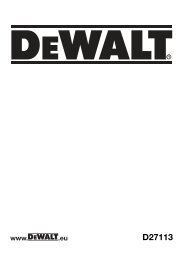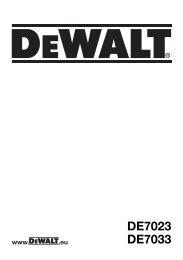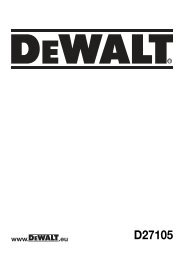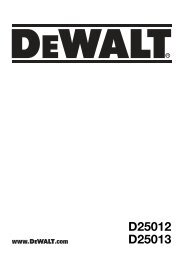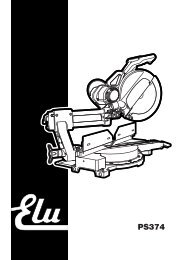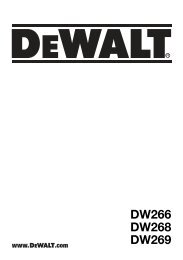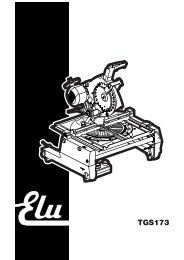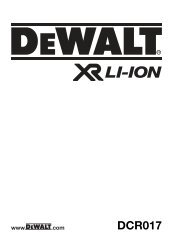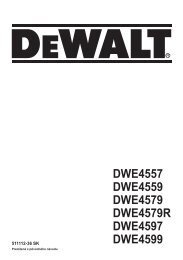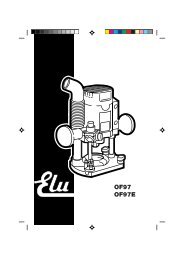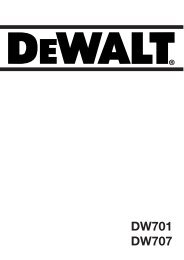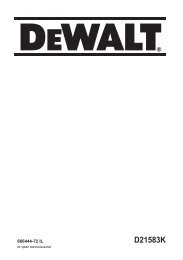XXXX man hammer D25103 Euro.indd - Service après vente - Dewalt
XXXX man hammer D25103 Euro.indd - Service après vente - Dewalt
XXXX man hammer D25103 Euro.indd - Service après vente - Dewalt
You also want an ePaper? Increase the reach of your titles
YUMPU automatically turns print PDFs into web optimized ePapers that Google loves.
ENGLISH<br />
f) If operating a power tool in a damp<br />
location is unavoidable, use a residual<br />
current device (RCD) protected supply.<br />
Use of an RCD reduces the risk of electric<br />
shock.<br />
3) PERSONAL SAFETY<br />
a) Stay alert, watch what you are doing and<br />
use common sense when operating a<br />
power tool. Do not use a power tool while<br />
you are tired or under the influence of<br />
drugs, alcohol or medication. A moment of<br />
inattention while operating power tools may<br />
result in serious personal injury.<br />
b) Use personal protective equipment.<br />
Always wear eye protection. Protective<br />
equipment such as dust mask, non-skid<br />
safety shoes, hard hat, or hearing protection<br />
used for appropriate conditions will reduce<br />
personal injuries.<br />
c) Prevent unintentional starting. Ensure<br />
the switch is in the off position before<br />
connecting to power source and/or<br />
battery pack, picking up or carrying the<br />
tool. Carrying power tools with your finger<br />
on the switch or energising power tools that<br />
have the switch on invites accidents.<br />
d) Remove any adjusting key or wrench<br />
before turning the power tool on. A<br />
wrench or a key left attached to a rotating<br />
part of the power tool may result in personal<br />
injury.<br />
e) Do not overreach. Keep proper<br />
footing and balance at all times. This<br />
enables better control of the power tool in<br />
unexpected situations.<br />
f) Dress properly. Do not wear loose<br />
clothing or jewellery. Keep your hair,<br />
clothing and gloves away from moving<br />
parts. Loose clothes, jewellery or long hair<br />
can be caught in moving parts.<br />
g) If devices are provided for the connection<br />
of dust extraction and collection facilities,<br />
ensure these are connected and properly<br />
used. Use of dust collection can reduce<br />
dust-related hazards.<br />
4) POWER TOOL USE AND CARE<br />
a) Do not force the power tool. Use the<br />
correct power tool for your application.<br />
The correct power tool will do the job<br />
better and safer at the rate for which it<br />
was designed.<br />
b) Do not use the power tool if the switch<br />
does not turn it on and off. Any power<br />
tool that cannot be controlled with the switch<br />
is dangerous and must be repaired.<br />
c) Disconnect the plug from the power<br />
source and/or the battery pack from<br />
the power tool before making any<br />
adjustments, changing accessories, or<br />
storing power tools. Such preventive safety<br />
measures reduce the risk of starting the<br />
power tool accidentally.<br />
d) Store idle power tools out of the reach<br />
of children and do not allow persons<br />
unfamiliar with the power tool or these<br />
instructions to operate the power tool.<br />
Power tools are dangerous in the hands of<br />
untrained users.<br />
e) Maintain power tools. Check for<br />
misalignment or binding of moving parts,<br />
breakage of parts and any other condition<br />
that may affect the power tool’s operation.<br />
If damaged, have the power tool repaired<br />
before use. Many accidents are caused by<br />
poorly maintained power tools.<br />
f) Keep cutting tools sharp and clean.<br />
Properly maintained cutting tools with sharp<br />
cutting edges are less likely to bind and are<br />
easier to control.<br />
g) Use the power tool, accessories and<br />
tool bits etc., in accordance with these<br />
instructions taking into account the<br />
working conditions and the work to<br />
be performed. Use of the power tool for<br />
operations different from those intended<br />
could result in a hazardous situation.<br />
5) SERVICE<br />
a) Have your power tool serviced by a<br />
qualified repair person using only identical<br />
replacement parts. This will ensure that the<br />
safety of the power tool is maintained.<br />
Additional Specific Safety Rules for<br />
Rotary Hammers<br />
• Wear ear protectors. Exposure to noise can<br />
cause hearing loss.<br />
• Use auxiliary handles supplied with the tool.<br />
Loss of control can cause personal injury.<br />
• Hold power tools by insulated gripping<br />
surfaces when performing an operation<br />
where the cutting tool may contact hidden<br />
wiring or its own cord. Contact with a “live”<br />
wire will make exposed metal parts of the tool<br />
“live” and shock the operator.<br />
• Use clamps or other practical way to secure<br />
and support the workpiece to a stable<br />
platform. Holding the work by hand or against<br />
your body is unstable and may lead to loss of<br />
control.<br />
27



